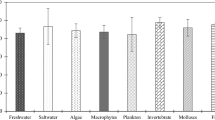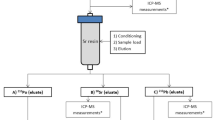Abstract
A new rapid method for the determination of 210Po in water samples has been developed at the Savannah River National Laboratory (SRNL) that can be used for emergency response or routine water analyses. If a radiological dispersive device event or a radiological attack associated with drinking water supplies occurs, there will be an urgent need for rapid analyses of water samples, including drinking water, ground water and other water effluents. Current analytical methods for the assay of 210Po in water samples have typically involved spontaneous auto-deposition of 210Po onto silver or other metal disks followed by counting by alpha spectrometry. The auto-deposition times range from 90 min to 24 h or more, at times with yields that may be less than desirable. If sample interferences are present, decreased yields and degraded alpha spectrums can occur due to unpredictable thickening in the deposited layer. Separation methods have focused on the use of Sr Resin™, often in combination with 210Pb analysis. A new rapid method for 210Po in water samples has been developed at the SRNL that utilizes a rapid calcium phosphate co-precipitation method, separation using DGA Resin® (N,N,N′,N′ tetraoctyldiglycolamide extractant-coated resin, Eichrom Technologies or Triskem-International), followed by rapid microprecipitation of 210Po using bismuth phosphate for counting by alpha spectrometry. This new method can be performed quickly with excellent removal of interferences, high chemical yields and very good alpha peak resolution, eliminating any potential problems with the alpha source preparation for emergency or routine samples. A rapid sequential separation method to separate 210Po and actinide isotopes was also developed. This new approach, rapid separation with DGA resin plus microprecipitation for alpha source preparation, is a significant advance in radiochemistry for the rapid determination of 210Po.










Similar content being viewed by others
References
Radiation Studies Branch, Division of Environmental Hazards and Health Effects, National Center for Environmental Health, Centers for Disease Control and Prevention, Atlanta. http://emergency.cdc.gov/radiation/isotopes/polonium/clinicians.asp
Scott B (2007) Health risk evaluations for ingestion exposure of humans to polonium-210. Dose Response 5(2):94–122
Miller C, Whitcomb R, Ansari A, McCurley C, Nemhauser N, Jones R (2012) Murder by radiation poisoning. implications for public health. J Environ Health 74(10):8
Steinhäusler F, Rydell S, Zaitseva L (2007) Risk due to radiological terror attacks with natural radionuclides. In: The natural radiation environment: 8th international symposium (NRE VIII). AIP conference proceedings 1034, Buzios, Rio de Janeiro, 07–12 Oct 2007, pp 3–15. doi:http://dx.doi.org/10.1063/1.2991254
Gleick P (2006) Water and terrorism. Water Policy 8:481–503. http://www.pacinst.org/reports/water_terrorism.pdf
Nemhauser JB (2010) The polonium-210 public health assessment: the need for medical toxicology expertise in radiation terrorism events. J Med Toxicol 6:355–359
Maxwell S, Culligan B (2012) Rapid determination of Ra226 in environmental samples. J Radioanal Nucl Chem 293(1):149–156
Maxwell S, Culligan B (2013) Rapid method for determination of 228Ra in water samples. J Radioanal Nucl Chem 295:2188–2191
Maxwell S, Culligan B, Noyes G (2010) Rapid separation method for actinides in emergency air filter samples. Appl Radiat Isot 68:2125
Maxwell S, Culligan B, Kelsey-Wall A (2012) Rapid determination of actinides in emergency food samples. J Radioanal Nucl Chem 292(1):339
Matthews K, Chang-Kyu K, Martin P (2007) Determination of 210Po in environmental materials: a review of analytical methodology. Appl Radiat Isot 65:267–279
Clayton R, Bradley E (1995) A cost-effective method for the determination of 120Po and 210Pb in environmental samples. Sci Total Environ 173/174:23–28
International Atomic Energy Agency (2006) Report on the second ALMERA coordination meeting and the ALMERA soil sampling intercomparison exercise—IAEA/SIE/01, IAEA/AL/164, p 36
Vajda N, La Rosa J, Zeisler R, Danesi P, Kis-Benedek GY (1997) A novel technique for the simultaneous determination of 210Pb and 210Po using a crown ether. J Environ Radioact 37:355–372
Horwitz P, McAlister D, Bond A, Barrans AB Jr (2005) Novel extraction chromatographic resins based on tetraalkyldiglycolamides: characterization and potential applications. Solvent Extr Ion Exch 23(3):319
Sill C (1974) Purification of radioactive tracers for use in high sensitivity alpha spectrometry. Anal Chem 46(11):1426
Currie LA (1968) Limits for qualitative and quantitative determination. Anal Chem 40:586
Frequently asked questions on USGS data on polonium-210 in wells in Lahontan Valley, Churchill County, Nevada. http://nevada.usgs.gov/polonium/FAQ.pdf. Accessed 25 July 2011
Seiler RL (2011) 210Po in Nevada groundwater and its relation to gross alpha radioactivity. Ground Water 49(2):160–171
Acknowledgments
This work was performed under the auspices of the Department of Energy, DOE Contract No. DE-AC09-96SR18500. The authors wish to acknowledge Rebecca Chavous, Jack Herrington and Staci Britt for their assistance with this work, as well as Dr. Dave Diprete of SRNL for providing the 210Po standard used in this work. The work by Dr. Dan McAlister at PG Research Foundation is very much appreciated.
Author information
Authors and Affiliations
Corresponding author
Rights and permissions
About this article
Cite this article
Maxwell, S.L., Culligan, B.K., Hutchison, J.B. et al. Rapid determination of 210Po in water samples. J Radioanal Nucl Chem 298, 1977–1989 (2013). https://doi.org/10.1007/s10967-013-2644-2
Received:
Published:
Issue Date:
DOI: https://doi.org/10.1007/s10967-013-2644-2




